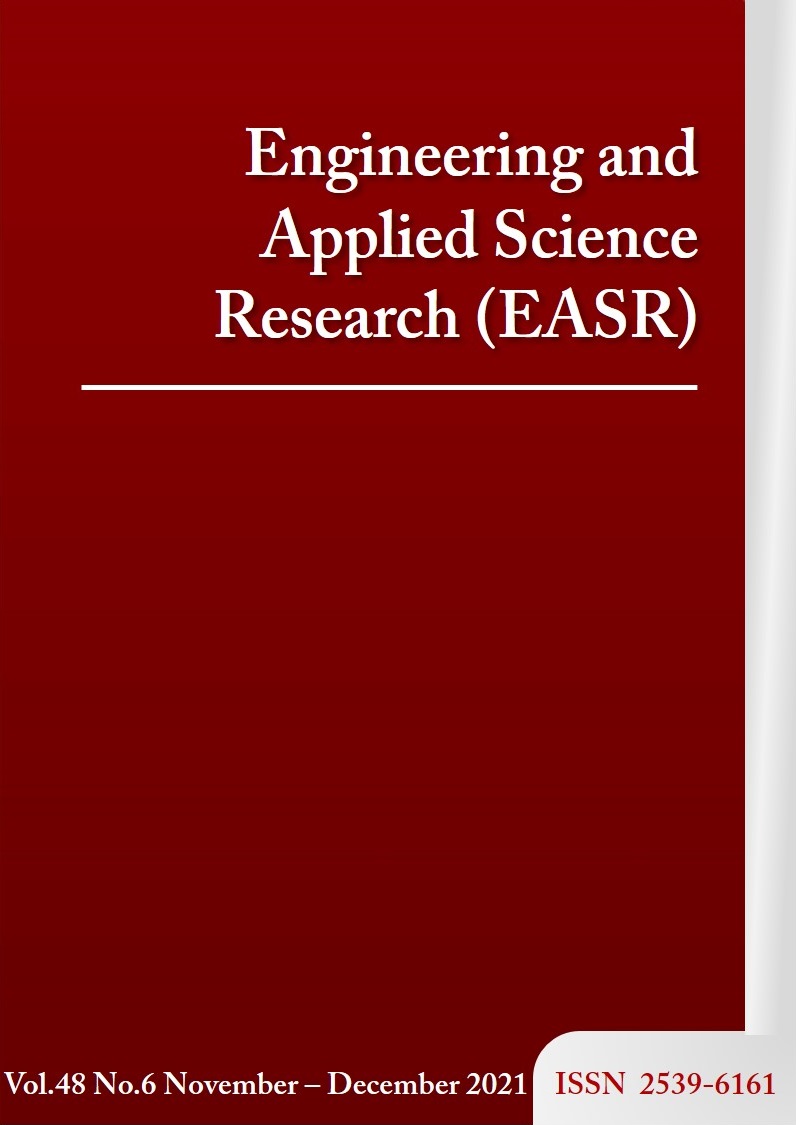Effects of operating conditions on quality attributes of instant brown rice porridge prepared by microwave assisted foam-mat drying
Main Article Content
Abstract
Foam-mat drying combined with microwave heating was applied to produce instant brown rice porridge. Concentration of egg albumin as a foaming agent and drying parameter, air temperature and microwave power were analyzed and optimized. Results showed that concentration of egg albumin of 18% (w/w) providing lowest foam density of 0.30 g mL-1, highest overrun of 223.54%, and an acceptably high value of foam stability (96.78%). Positive effects were observed with rehydration ratio and color change inversely related to drying time. Both drying parameters favorably affected textural properties including firmness, consistency, cohesiveness and viscosity index of the rehydrated samples. Response surface methodology showed good quadratic and linear correlations between input parameters for all responses, with R2 ranging 0.81-0.99, except for the response of viscosity index (0.56). Optimal drying air temperature of 72°C and microwave power of 300 W were obtained and used for model validation. Small discrepancy errors for textural properties ranging 3.48%-24.73% showed a good basis for practical use in producing instant rice porridge.
Article Details
This work is licensed under a Creative Commons Attribution-NonCommercial-NoDerivatives 4.0 International License.
References
[2] Rhim JW, Koh S, Kim JM. Effect of freezing temperature on rehydration and water vapor adsorption characteristics of freeze-dried rice porridge. J Food Eng. 2011;104(4):484-91.
[3] Jittanit W, Lalitmassakul C, Charn-Utsar P. Quality of instant congee and energy consumption in the drying process by using drum dryer. J Syst KMUTNB. 2012;22(2):256-64.
[4] Nyombaire G, Siddig M, Dolan KD. Physico-chemical and sensory quality of extruded light red kidney bean (Phaseolus vulgaris L.) porridge. LWT-Food Sci Technol. 2011;44(7):1597-602.
[5] Zheng XZ, Liu CH, Zhou H. Optimization of parameters for microwave-assisted foam mat drying of blackcurrant pulp. Dry Technol. 2011;29(2):230-8.
[6] Muthukumaran A, Ratti C, Raghavan VGS. Foam-mat freeze drying of egg white-mathematical modeling part II: freeze drying and modeling. Dry Technol. 2008;26(4):513-8.
[7] Hardy Z, Jideami VA. Foam-mat drying technology: a review. Crit Rev Food Sci Nutr. 2017;57(12):2560-72.
[8] Qadri OS, Srivastava AK. Prototype continuous microwave foam-mat dryer: design and fabrication. J Food Sci Technol. 2021;58(9)3357-67.
[9] Muthukumaran A, Ratti C, Raghavan VGS. Foam-mat freeze drying of egg white-Mathematical modeling part I: optimization of egg white foam stability. Dry Technol. 2008;26(4):508-12.
[10] Kudra T, Ratti C. Foam-mat drying: energy and cost analyses. Can Biosys Eng. 2006;48:3.27-3.32.
[11] Qadri OS, Srivastava AK. Effect of microwave power on foam-mat drying of tomato pulp. Int Agric Eng J. 2014;16(3):238-44.
[12] Sun Y, Zhang Y, Xu W, Zheng X. Analysis of the anthocyanin degradation in blue honeysuckle berry under microwave assisted foam-mat drying. Foods. 2020;9(4):397.
[13] Qadri OS, Srivastava AK. Microwave-assisted foam mat drying of guava pulp: drying kinetics and effect on quality attributes. J Food Process Eng. 2017;40(1):e12295.
[14] Kanha N, Regenstein JM, Laokuldilok T. Optimization of process parameters for foam mat drying of black rice bran anthocyanin and comparison with spray-and freeze-dried powders. Dry Technol. In press 2020.
[15] Tan MC, Chin NL, Yusof YA, Taip FS, Abdullah J. Characterization of improved foam aeration and rheological properties of ultrasonically treated whey protein suspension. Int Dairy J. 2015;43(7):7-14.
[16] Rajkumar P, Kailappan R, Viswanathan R, Raghavan GSV, Ratti C. Foam mat drying of alphonso mango pulp. Dry Technol. 2007;25:357-65.
[17] AOAC. Official of analysis of AOAC International. 17th ed. Arlington, USA: AOAC International; 2000.
[18] Ng ML, Sulaiman R. Development of beetroot (Beta vulgaris) powder using foam mat drying. LWT-Food Sci Technol. 2018;88:80-6.
[19] Syahariza ZA, Yong HY. Evaluation of rheological and textural properties of texture-modified rice porridge using tapioca and sago starch as thickener. Food Measure. 2017;11:1586-91.
[20] Candioti LV, de Zan MM, Camara MS, Goicoechea HC. Experimental design and multiple response optimization. Using the desirability function in analytical methods development. Talanta. 2014;124:123-38.
[21] Sangamithra A, Venkatachalam S, John SG, Kuppuswamy K. Foam mat drying of food materials: a review. J Food Process Preserv. 2014;39(6):3165-74.
[22] Falade KO, Adeyanju KI, Uzo-Peters PI. Foam mat drying of cowpea (Vigna unguiculata) using glyceryl monostearate and egg albumen as foaming agents. Food Res Technol. 2003;217:486-91.
[23] Abbasi E, Azizpour M. Evaluation of physicochemical properties of foam mat drying dried sour cherry powder. LWT-Food Sci Technol. 2016;68:105-10.
[24] de Col CD, Tischer B, Flores SH, Rech R. Foam-mat drying of bacaba (Oenocarpus bacaba): process characterization, physicochemical properties, and antioxidant activity. Food Bioprod Proc. 2021;126:23-31.
[25] Benkovic M, Pizeta M, Tusek AJ, Jurina T, Kljusuric JG, Valinger D. Optimization of the foam mat drying process for production of cocoa powder enriched with peppermint extract. LWT-Food Sci Technol. 2019;115:108440.
[26] Sankat CK, Castaigne F. Foaming and drying behavior of ripe bananas. LWT-Food Sci Technol. 2004;37:517-22.
[27] Shaari NA, Sulaiman R, Rahman RA, Bakar J. Production of pineapple fruit (Ananas comosus) powder using foam mat drying: effect of whipping time and egg albumin concentration. J Food Process Preserv. 2018;42:e13467.
[28] Karim A, Wai C. Characteristics of foam prepared from starfruit (Averrhoa carambola L.) puree by using methyl cellulose. Food Hydrocoll. 1999;13:203-10.
[29] Qadri OS, Srivastava AK, Yousuf B. Trends in foam mat drying of foods: special emphasis on hybrid foam mat drying technology. Crit Rev Food Sci Nutr. 2020;60:1667-76.
[30] Dehghannya J, Pourahmad M, Ghanbarzadeh B, Ghaffari H. Heat and mass transfer modeling during foam-mat drying of lime juice as affected by different ovalbumin concentrations. J Food Eng. 2018;238:164-77.
[31] Dehghannya J, Pourahmad M, Ghanbarzadeh B, Ghaffari H. Heat and mass transfer enhancement during foam-mat drying process of lime juice: impact of convective hot air temperature. J Food Eng. 2019;135:30-43.
[32] Fu T, Niu L, Wu L, Xiao J. The improved rehydration property, flavor characteristics and nutritional quality of freeze-dried instant rice supplemented with tea powder products. LWT-Food Sci Technol. 2021;141:110932.
[33] Puspitowati S, Driscoll RH. Effect of degree of gelatinization on the rheology and rehydration kinetics of instant rice produced by freeze drying. Int J Food Prop. 2007;10:445-53.



